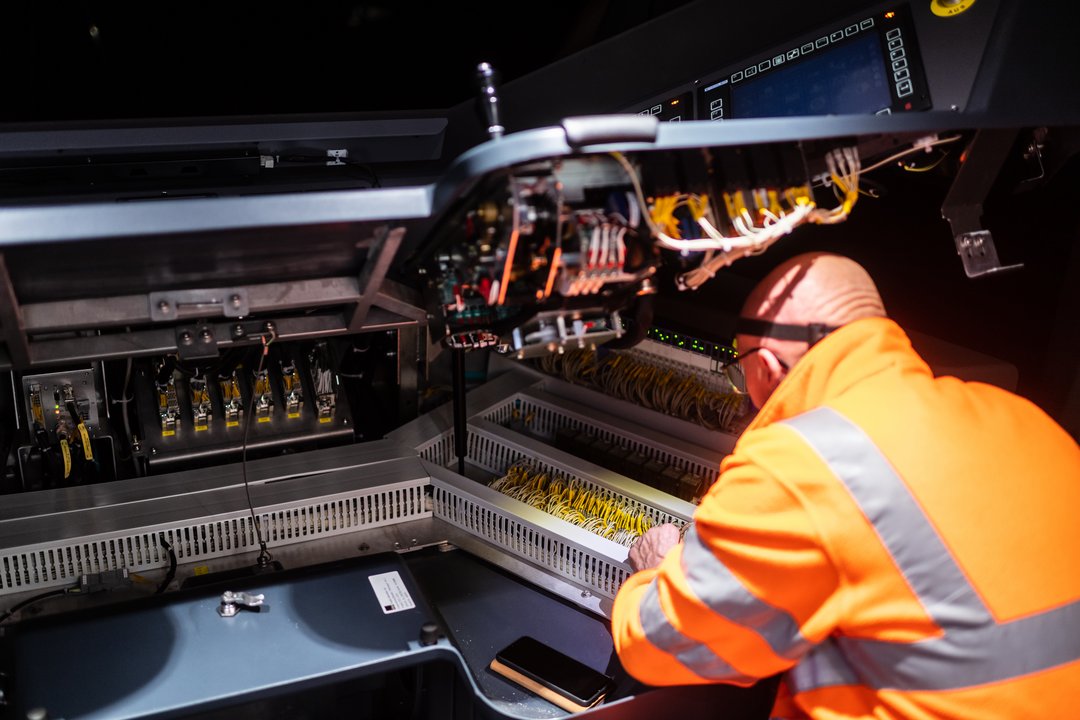Warenkorb
Sie haben keine Produkte im Warenkorb.
“We wouldn't be attempting it if we didn’t think we would be successful.” The nocturnal sufferings and joys of a project manager at Stadler. Florian Thieme and the long road to the world record attempt.
He could fill an entire book with his anecdotes and experiences from the eight months between the birth of the idea and the world record attempt: Florian Thieme, technical project manager at Stadler for the Capricorn railcars
Twenty-five formations of four carriages made up of these new flagship vehicles from Stadler make up the world-record train.
Mr. Thieme: How long have you had the idea of trying to set a world record?
It’s been a while. The first crazy ideas were forged by RhB two years ago with the involvement of Stadler. Eight months ago, the project took on more concrete forms. Now we are on the verge of touchdown.
And how does that feel?
Good, I’d say. Of course, we are still very tense and nervous – and we will be right up to the last minute. During the attempt, we’ll be in the vehicles in case of a malfunction. If things go as planned, we can also enjoy the ride.

And what are the chances of the experiment succeeding?
(thinks briefly) I would say: at least 95%. You know, we wouldn’t be competing if we weren’t very sure about what we were doing. But there’s always a certain amount of risk, however much you have prepared. It’s part of the game. We’ve already had some experience of that during the tests beforehand…
Things didn’t always go as smoothly as you had imagined. Are there any secrets you can reveal?
Yes, of course. The absolute low was 10 April 2022. That was the first test with 16 formations. Nothing worked. The train was stuck in the Albula Tunnel and wasn’t budging.
Why?
That was what we were wondering. And I can tell you: my colleagues and I – all highly experienced technicians – were frantically looking for the proverbial needle in the haystack. In vain. Despite intensive troubleshooting, we were unable to activate the essential safety loop across all railcars. And so it was impossible for us to get the train going.
Why?
The emergency brake loop between all formations is the essential safety precaution – it is the safety system that allows any of the seven drivers to apply an emergency brake at any time and bring the entire train to an immediate stop.
What have you done since then to make it work?
We worked a lot of night shifts (laughs). I’m not joking. We searched intensively for new programming and an open-end solution. And the following always applies: keep things as simple as possible, not too complicated, otherwise the systems become vulnerable. This is also particularly important as we have to reprogram all formations for regular traffic after the attempt.

How many Stadler specialists are involved in this team?
There are nine of us working directly on the world record attempt. One IT technician, one electrician and six IBS specialists – these are specialists responsible for commissioning – and me.
And what’s your role?
I am the master of ceremonies as coordinator of the Stadler team and interface with the technical management of RhB. When we’re not busy breaking records, I’m responsible for delivering all the Capricorn railcars to RhB.
How long have you been with Stadler?
Since 2014. I’m the next generation. In recent years, there’s been a change of guard on the teams that work for RhB. Our long-standing employees, some of whom had worked with RhB for more than 20 years, have retired. Now it’s time for us 35-year-olds. And the world record attempt is an ideal testing ground for us – also in terms of team building.
And what do you think you’ll be doing the night before the big record attempt?
We will receive the first “Capricorn” railcars in Samedan the evening before at 7:30 pm and reprogram their systems for the world record. This will go on until around 2 or 3 am, when we have prepared around 13 railcars in terms of IT and set them up in the Albula Tunnel. Then we’ll fall into bed – in our hotel in Preda, before we go back to work at 7 am. Everything has to be ready by 1:45 pm so that the world record attempt can then work like clockwork.
And what will you do if you’re successful?
Hopefully we’ll celebrate at the festival site in Bergün. Because then we’ll definitely have to raise our glasses – including to all the colleagues who are not in the limelight. They have contributed a great deal to the success, sometimes over the course of several months. We owe them our sincere thanks.
No comment has been made yet.
What do you think?